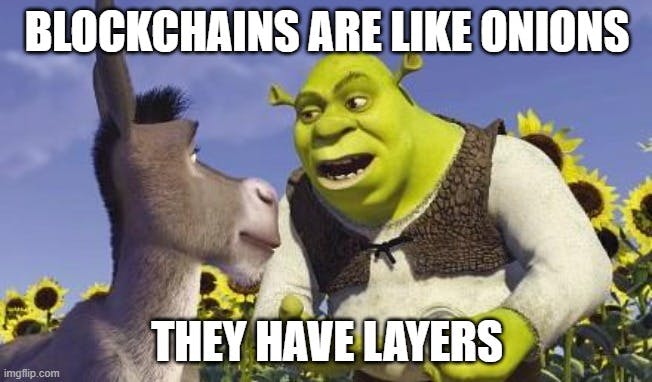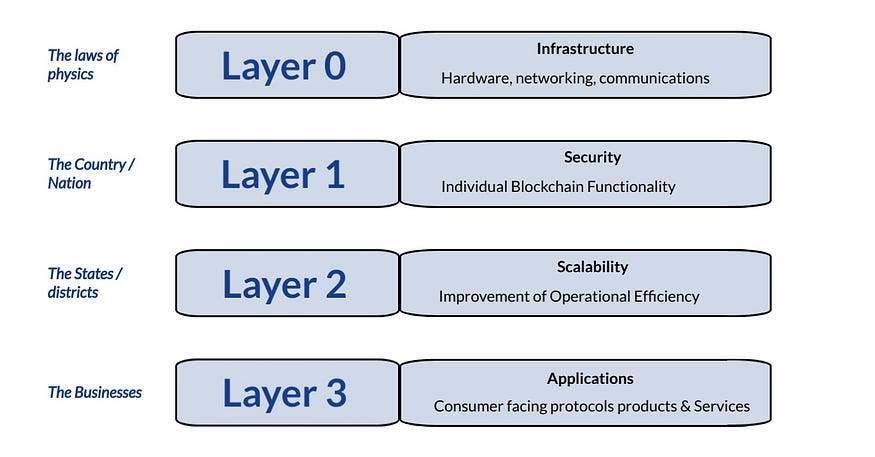
Blockchain: Layers 0–3
The 4 Layers of Crypto Networks
Blockchains are like Onions, they have layers
- Shrek on distributed ledger technologies

Odds are that if you are alive in the 21 century, you have heard the term blockchain at least once. It is the magic pixie dust that powers distributed ledgers and imbues cryptocurrencies such as Bitcoin and Ethereum with “trust”.
Since its arrival in the public domain, some 14 years ago, this nascent technology has undergone countless iterations and become the colloquial backbone of the digital economy.
Throughout its evolution, hundreds, if not thousands, of different versions of blockchains have arrived on the marketplace all claiming to be different and promising to solve some kind of existential problem. Regardless of the variance in their designs or marketing tactics, at the highest level, the overarching purpose of all blockchain technology can be boiled down to the distribution and securitization of information under a ridged data structure.
Given the hyperbolic rate of innovation taking place in the sector, it becomes difficult to understand what exactly they are providing and distinguish them from one another.
Ultimately, one of the most effective methods used in the industry today for classifying/categorizing them is according to the four-layer framework based on the function of their implementation.

This is the foundation upon which distributed computation takes place.
A helpful way to think about layer 0, is to think about traditional internet protocols. Hardware and networking reside on this layer.
In order for a blockchain to operate there must be equipment that hosts software to interact with circuit boards that are fed binary code in order to configure their transmission, connectivity, and other base functionality.
Just like phones require radio frequency waves to actually capture signals and connect to one another, Blockchains need some kind of medium through which they send their messages. For older-generation networks such as Bitcoin, the traditional internet protocol TCP/IP catalyzes this. This has been necessary but sub-optimal as there is a dependency on centralized ISPs (Internet Service Providers).
Moreover, blockchains (up until recently) have not been compatible. They have been siloed systems that do not have a standard for communicating with each other. Recent innovations such as IBC (Inter-Blockchain-Communication) provided by the Cosmos network, have begun to slowly disintermediate ISPs by allowing blockchains to send messages between themselves.
Tl,dr: elements beyond just data structure, hardware and networking.
Examples of Layer 0: Cosmos, Polkadot, Avalanche
Synonymous with architecture, security, decentralization, and ownership; Layer 1 refers to the core tenets of how a distributed ledger is implemented.
Sometimes referred to as the “implementation layer” Layer 1 pertains to the fundamental operations of an individual distributed ledger.
Designed to provide guarantees of immutability, Layer 1 includes all of the unique elements of a blockchain such as block time, programming language, client software, and consensus mechanism.
Given that security is the main driving force here, layer 1 is considered to be the settlement layer for transactions, much of the narrative of trust in decentralized systems comes from this layer.
Constrained by the physical bounds of computation (i.e. bandwidth) L1 suffers from diminishing operational efficiencies alongside increased adoption (as more users join the network, it becomes slower).
Tl,dr: a blockchain network’s basic functionality.
Examples of Layer 1: Bitcoin, Ethereum, Solana
Secure computation is expensive and confined within a tight range of processes, that is where the entire reason for being for Layer 2 comes in, to increase the efficiencies of its underlying Layer 1.
Inheriting the primitives and security guarantees from their mother chain; Layer 2s move the vast majority of computation off the main layer and periodically push attestations of their activity back to the base chain. That is why some decentralization maximalists refer to L2s as “off-chain” activity.
Once the boundaries/maximal capabilities/threshold of layer one were realized, innovation at this layer began to blossom. Resulting in many interesting technological solutions such as sidechains, state channels, rollups, and sharding being developed.
Sidechains are exactly what they sound like, a chain that runs in parallel to another chain. Many similarities to an L1 in the sense that they are open ledgers with a sequenced list of transactional blocks that provide some kind of guarantees, sidechains differ primarily in their consensus models. Layer 1 consensus models are optimized for security and decentralization whereas layer 2 sidechain consensus models are optimized for throughput; thus making them more centralized.
State channels are secure communication pipelines. Employed through a bi-directional multi-signature structure, this technology is not as transparent as the other alternatives and does not have a consensus model for miner/transaction validation. Instead, all of the activity that takes place on a state channel happens privately between the channel’s service providers. Closer to being considered almost fully off-chain.
Rollups are far more complex than the prior two to explain, but at the highest level, rollups are somewhere between an L1 and L2. Nested on the main layer rollups keep transactional data secure within the original environment. However, the processing of transactional data happens off-chain.
A Layer 1 can have many different Layer 2’s deployed to it.
A high-level way of thinking about this technical topology is federations, smaller states within a nation. If you live in America, you can choose which state you prefer. Every state will have its own specific laws and ideologies but all states will share basic human laws under the umbrella of the federal government.
Tl,dr: an extension of a blockchains operational funtionality and capacity.
Examples of Layer 2: Lightning Network, Polygon, Optimism, Arbitrum
Perhaps the most intuitive of all the layers, end-user functionality exists on layer 3.
Tasked with abstracting away the technical complexity of blockchain technologies, L3 is where DAPPs and user-facing protocols are hosted.
This is where the digital world of binary code and smart contracts finds its real-world applicability. Interaction with this layer involves a GUI (graphic user interface) for utilizing the broad range of trusted encrypted software tooling such as proving liquidity, trading, making payments, and staking among other things.
Tl,dr: Tokens, wallets, DEXs, NFTs and everything in between.
Examples of Layer 3: AAVE, Uniswap, Compound, OpenSea, Metamask
This should now give you a concrete understanding of what the term “Layers” means in the general context of crypto and blockchain.
There does exist another conversation around blockchain layers that pertains to the low-level structure of the technology itself. If you are interested in finding out how blockchain architecture is structured I provided an introductory framework called: “The 5 Layers of Technology in Blockchain Crypto Networks”.
It's been an absolute pleasure going over this!
I hope you find this helpful on your journey through the blockchain 😁
Thank you for reading!
See you all on the other side 🥂


